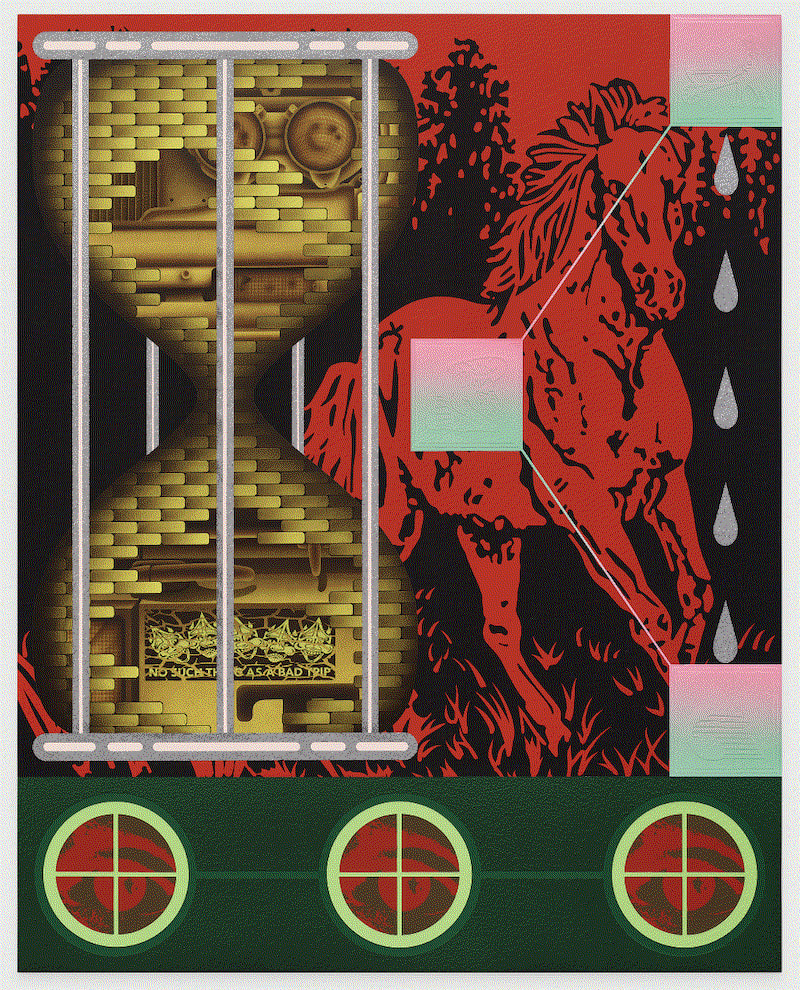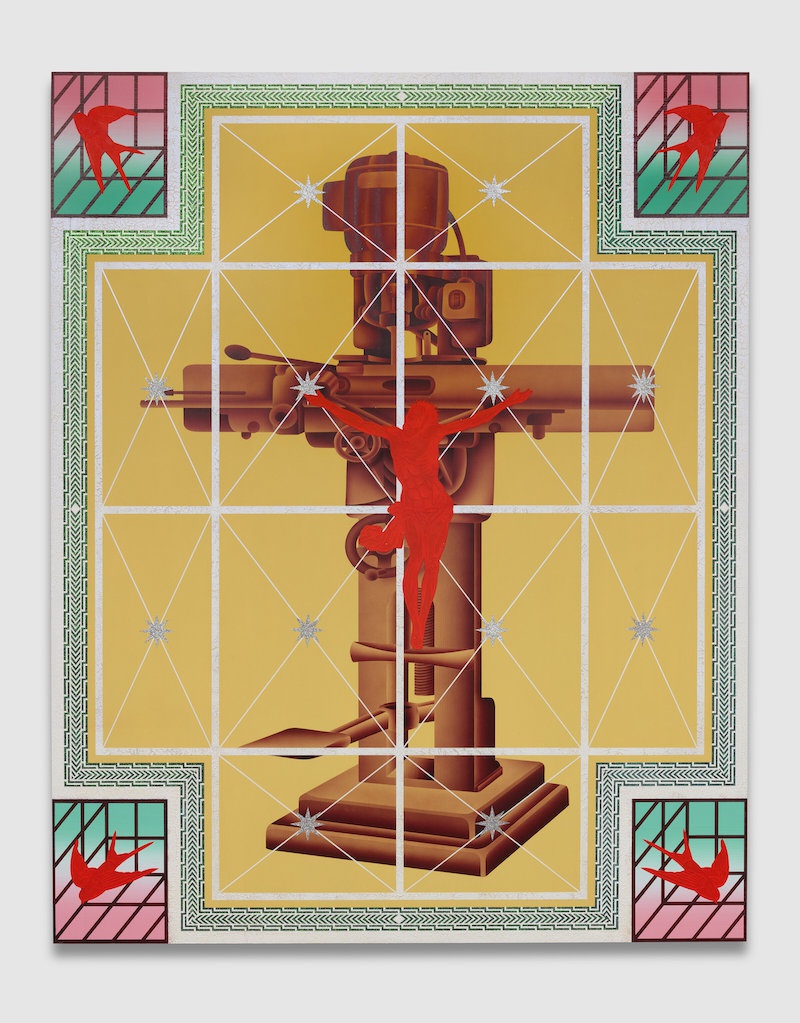
READ THE FULL FEATURE
Pomona, California, situated east of downtown Los Angeles, between the San Gabriel and San Bernardino Mountains, in what was once known as the citrus triangle, is a bit of a gateway into the Inland Empire. It suggests the perfect cinematic backdrop for stories about cars, freeways and commutes, its university campuses and sprawling city plan buzzing with the hallmarks of motion to and fro. Jaime Muñoz calls Pomona home, and throughout his career, this intrigue with commutes and cars as symbols and inspiration, has created intricate and layered acrylic and airbrush paintings that present the panoramic culture clashes that exist in the fabric of southern California iconography. His work often examines the vehicle as a symbol for class and race, function and support. Emerging from UCLA to the studio of Chris Burden, and now enjoying a burgeoning and blossoming fine art career, Muñoz found time, after a trip to EXPO Chicago, to chat with me over the course of a few weeks in Pomona. He shares a broad, nuanced view of the sprawling span of California’s rich history.
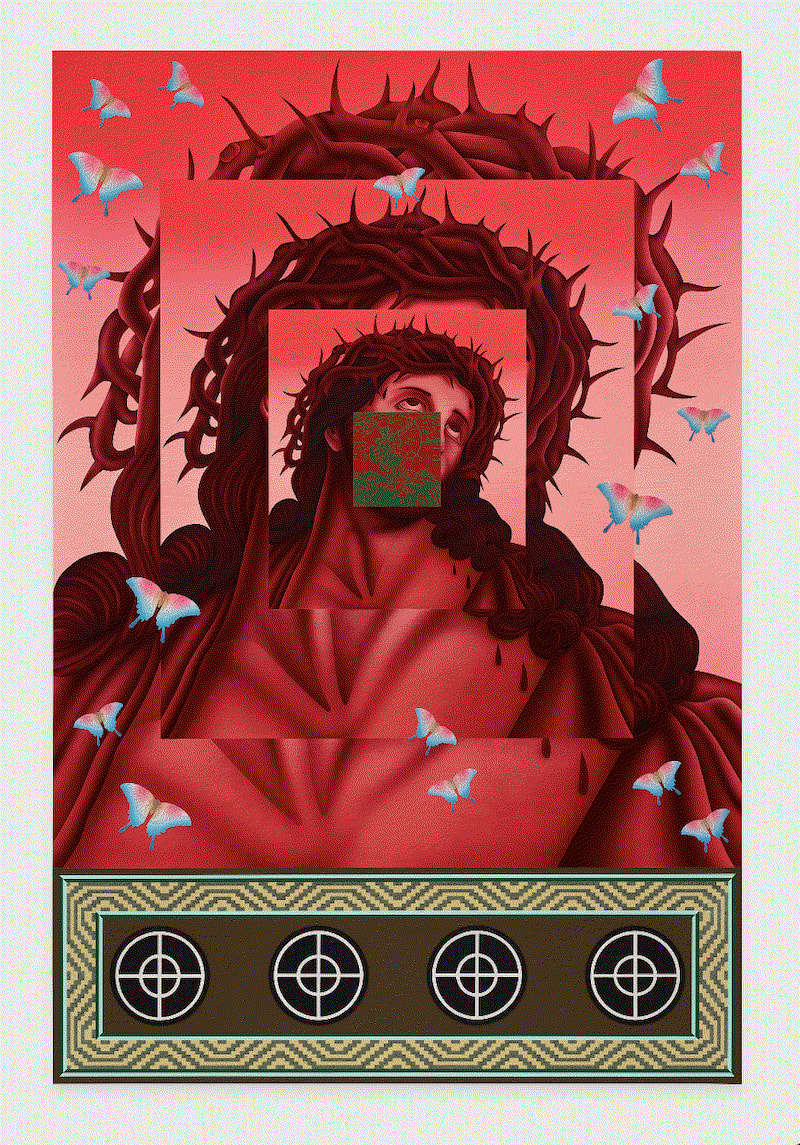
Evan Pricco: I didn't imagine starting this way, but as I wondered about how we were going to do this interview, I thought a lot about car culture, and cars in general, and the theme of mobility hovers over. Is this a good place to start?
Jaime Muñoz: Yes, movement does resonate with me. It makes me think about my experience commuting to work. I get a lot of inspiration for my paintings when I’m on the road. Initially, I worked for a structural concrete company called Slater Inc. in Fontana, California. In those years, I would commute from Fontana into different areas of the high desert. A little later, from around 2012 to 2019, I was commuting from Pomona to Topanga Canyon, when I worked for Nancy Rubens and Chris Burden as a studio assistant.
This narrative around commuting started in my work in 2019, in the painting, Morning Commute. In that work, I was just interested and drawn to R-series Toyota mini trucks that I saw commonly used as utility trucks for different laborers. I was thinking about making something from my experience, which in this case, was a commute. The back of the vehicle is emblematic of the commute because that’s what you stare at when you sit in traffic for long hours and I guess that image has been ingrained in my mind.
I had read about Toyoteria and how that plays into your work, so I wonder, could you explain that? And where did the term come from?
Toyoteria is a term that was born out of conversations about Toyota mini trucks, so that broadly means anything related to that subject. I used the word as a title in one of my paintings and people started questioning and wanting to understand further what the word meant. To me, Toyoteria is working on Toyota pickup trucks with my brothers, looking for parts at the junkyard, and machining parts in my mom’s garage. In general, because I was using these cars to drive on long commutes, I was tuning my car to run as efficiently as possible.
Similar to lowriders, hot rods, rat rods, and dekotora trucks in Japan, I wanted to create a new term to contribute to car culture on the west coast that was specific to this aesthetic that I saw happening in the Toyota mini trucks. I wanted to create a new dialogue around these vehicles that inserted these unseen narratives in car culture that reflected identity and emblems around the worker and labor that made these trucks unique.
What I love about your work is that there is such a fine art technique mixed with a utilitarian quality, which comes from the way you use imagery and layering. It's almost like a roadmap of our current world. Where do you even start with your paintings?
Recently, I’ve started a new practice that incorporates diagram drawing to explore different ideas in my work. These drawings provide me space to investigate and consider imagery and the conceptual, intuitive ideas that may foreshadow subjects of the paintings. As I juxtapose different images together, I am able to sort through and examine the relationships of various images. In this way, the diagram is a space for my internal process of discovering associations.
The process of creating a design and developing a composition is heavily influenced by my background in commercial art. I lay out my ideas in Adobe Illustrator and carefully plan the layering process. The design in Illustrator functions like a blueprint for the work. It guides how I plan out the construction of the painting.
I have interviewed more than a few Los Angeles based artists recently, but my favorite part is that each has come with their own interpretations of the place, and all were born here. How much of LA is in your work?
I was born in LA, but I actually grew up in Pomona, Rialto and Fontana. Currently, I live and work in Pomona. I did commute through Los Angeles for many years, and the concepts I depict in my work are literally memories of what I saw and experienced on the road.
In a time when so many monuments are being torn down across the country, the LA freeway system is definitely one of Los Angeles’ biggest monuments reflective of racism and gentrification. The Federal Aid Highway Act was passed in 1956 authorized $25 billion dollars for the construction of 41,000 miles of Interstate Highway System over a 10 year period. During this time Jim Crow laws were still in effect, and it's no surprise that you would see its influence in the design and planning of the Los Angeles freeway system. White dominated municipalities nationwide routed freeways through communities of color and segregated black and white neighborhoods. The 10 freeway is a good example in how it splits the affluent northern areas of LA from some of the economically struggling black and brown areas of South LA. It's been interesting driving through these highway systems over the years and thinking of this history and seeing the outcome of it all firsthand..
Another area where LA has influenced my identity was during undergrad at UCLA between 2014-2016, specifically, my experience commuting to school. I would take the Purple or Red Metrolink to Union Station, then take the red line to Hollywood and Highland, then walk to the #2 bus near Hollywood High that would then take me straight to the Northern part of the UCLA campus. Later I discovered that my grandma had taken the same route to go clean houses in Beverly Hills. I would see all the women workers commuting and think of my grandmother. It was interesting to go from driving to public commuting. One is very isolating and the other is very communal. I would reflect on many of my ideas during that commute and it created a space for me to incubate my thoughts.
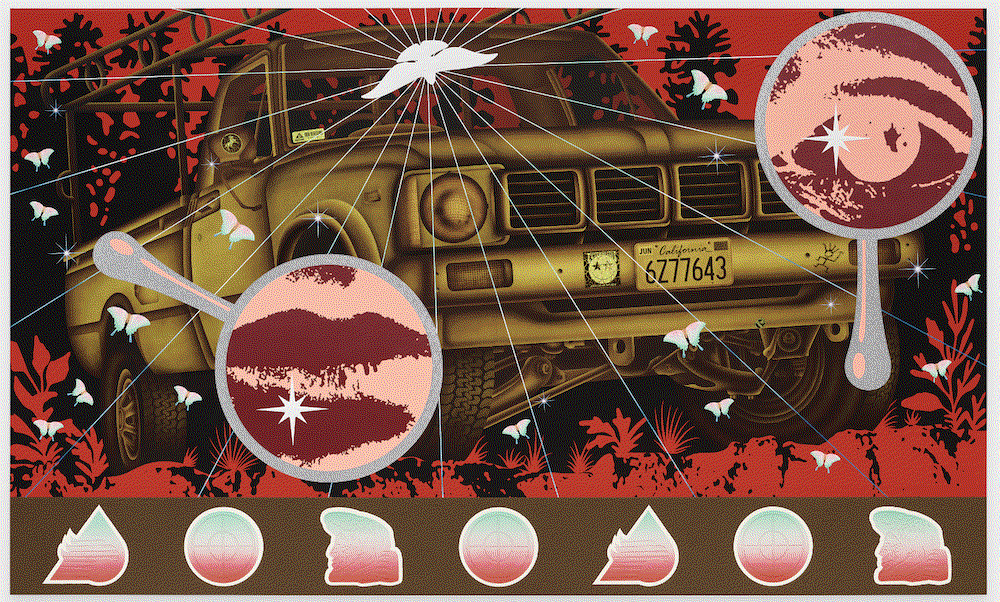
Each artist also speaks about the dynamics of movement within labor and the working class when they are making work about LA. Patrick Martinez remarked that LA "feels that it's still in process, or kind of like it has not yet arrived." I wondered what you feel about that sort of movement, and if you think that perhaps because labor feels unstable is that it is often moving around LA? I always think of LA artists as trying to freeze frame instability.
I’ve never thought of myself as an artist who makes work about LA, although one of the central focuses in my work is commodity labor, and that theme definitely has a place in LA or any city wherever industry and labor exist. I do believe that this feeling of instability within labor is due to the constant conflict that working people face daily just to survive.
Considering that such a powerful list like Barbara Kruger, Lari Pittman, and Rodney McMillian, for example, taught at UCLA, I imagine that studying there must have been very enriching. What was that experience like? It feels like conceptually, it was a good place to be. And, SoCal was still home, so you had the opportunity to study in your own backyard.
It was very challenging at first because I was commuting all the way from Pomona and felt like it interfered with the quality of my education. I didn't want to get more into debt by getting loans to live on or near campus, so I took it as a sacrifice and commuted. I ended up spending more time commuting than on campus, and by the time I made it home I was exhausted. I realized I was not going to last if I continued commuting, so after the first quarter I started camping out of my truck and that was a lot better. Since students have 24-hour access to the campus studios. I spent the majority of my time in the studio studying for tests and doing homework. I was also able to participate in school activities more so it was nice being active in that way.
UCLA’s art program is conceptually focused and I wanted to go there because I felt a desire to expand my capacity to conceptualize my ideas. I think the program really pushed me in that direction and exposed me to deeper ways of examining life and my work. It helped shape my confidence in my perspective and enhanced my ability to express and discuss my ideas. At the same time, it also exposed the blindspots of the institution, and the limitations of the art canon. I would find myself in many debates between formalist ideas and ideas that subverted those standards.
I loved getting to work with Lari Pitman, Jennifer Bolande, and Patty Wickman. They all influenced me greatly. I started exploring mixed media deeply in my painting with Lari. For New Genres, I had Jennifer, who greatly influenced my video and photography practice. I had Patty for drawing, and I would say she's the reason I’ve continued to make drawings. I also took a lot of Chicano Studies classes during my time at UCLA, where Alma Lopez and Alicia Gaspar De Alba both inspired and influenced me greatly. Lastly, there was a Working Class history class that I took with Frank T. Higbie, and I would probably say his class had the most impact on me. In his class I learned a lot about the unresolved conflicts that working class people face, thus raising the paradoxical question, can industry and democracy coexist? That is a question that I continue to explore today.
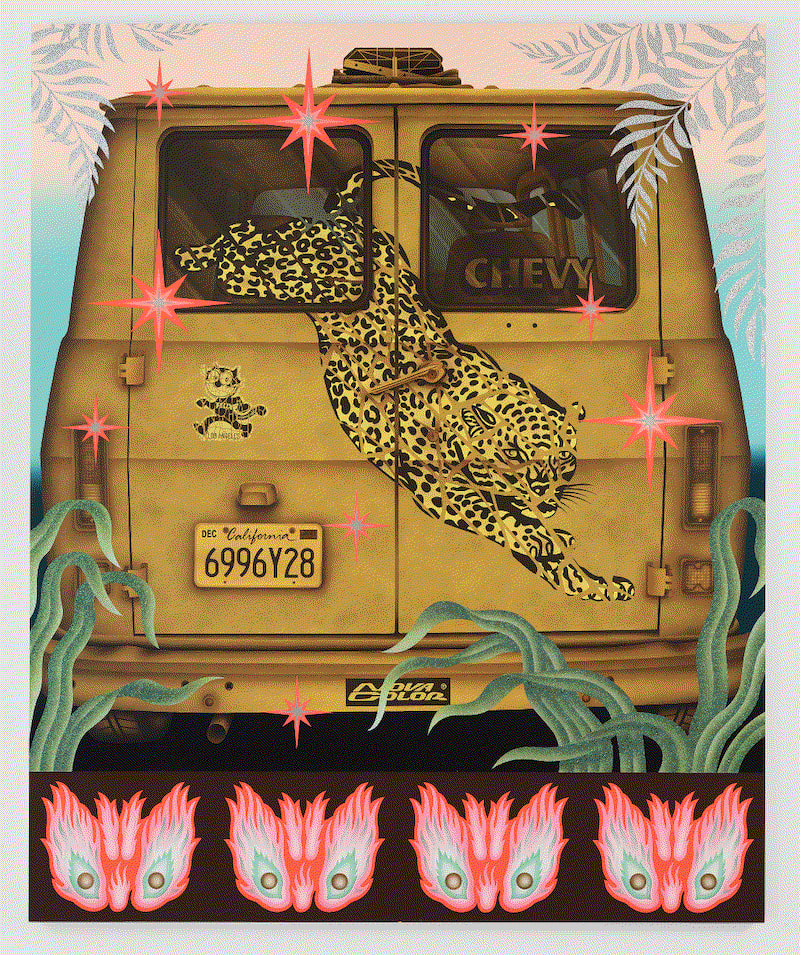
Your career has attracted so much attention recently, and when I told other artists I was interviewing you, so many of them expressed such curiosity and interest in what you are doing. Did you feel a change in the last year, and do you feel a certain pressure in the studio now that more eyes and asks are coming your way?
Sometimes I feel pressure to have work present in my studio at all times, but given the nature of my process, I have felt a change. It's interesting working at the commercial level. Right now I find myself having to constantly work so that I can meet the demand, while at the same time, having work to show during studio visits. It's been challenging finding a healthy balance between work and life outside of it. I've also been thinking about the volume of work that I make a year, and since the process is very time consuming I’d say my production is on the lower end. I'd like to increase my production a little, but we'll see how it goes. Currently the studio team consists of my two brothers and me. It's been great working closely with them because we've worked together our whole lives.
What is the best advice you received in the last year?
The best advice I received recently was actually from my mom. She emphasized to me that there is a difference between resting and quitting. She shared that it's important to recognize that our body needs rest, and that although we may need space and time for rest, that doesn’t mean we have to give up on our goals or feel guilty for resting.
I have to ask because I think it matters and I think that it helps shape who you are as a creative mind, but where does graffiti fit into your work?
I stopped writing when I was 17, so I wouldn’t really consider it a very central influence in my work currently, although I have a lot of respect for graffiti and have a lot of friends who continue to have strong ties in that world.
I am still very interested in typography and alternative forms of communication. I've been fascinated by hobo code, which is a form of graffiti. Hobo code was a pictographic system of symbols that the nomadic working class used during the Great Depression of the 20th Century. These nomadic workers roamed the country by freight train and took work wherever they could and never spent too much time in one place. They were also not typically welcomed, thus messages left for each other in the community had to be easy to read, while at the same time, secretive. Some of the things that they would communicate would be safe places to sleep, dangerous places to avoid, the location of police, and where stable work could be found.
Do you miss graffiti? I know that sounds weird, but do you miss the rush of it? The sort of inherent chaos? Because your work now is just so tight.
Graffiti had its time and place in my life, but my current work occupies so much space and time, I honestly don’t consider that. Sometimes I'll write hobo code to communicate things to the people who can read it.
I know you have had to answer this question before, but "blood memory" is a concept that comes up whenever I research your work. Can you tell me what that means, and maybe what that means for a first generation American who is creating a visual identity and fine art that abstractly describes a particular life experience?
Blood Memory is a concept that relates to the inherent memory that we carry through our DNA. This concept interests me, as it pertains to colonial history as well as recent histories that are connected to traumatic experiences that we inherit through family.
I'm not sure what’s upcoming, but when you are in the early stages of prepping a show, what does your research look like? What is in the Jaime Munoz research lab right now?
Currently I’m working on a show for Francois Ghebaly LA in the Fall and I’ve been exploring narratives around decorated utility trucks. I’ve been drawn to the Dekotora truck culture in Japan and have been watching videos and reading books. Similar to the Toyota R- series work truck and Toyoteria, I've been attempting to expand the dialogue by finding the working class aesthetic of all work trucks on the West Coast that is not limited to just Toyota pickups. Spending time on the road is still a component to my research process. I've also been working on a lot of drawings that aid the composition process of the paintings.
All images courtesy of the artist and Juxtapoz.





